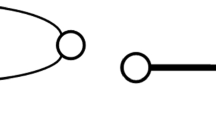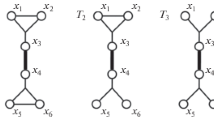Abstract
In the article, the definition of an undirected multiple graph of any natural multiplicity \(k > 1\) is stated. There are edges of three types: ordinary edges, multiple edges, and multi-edges. Each edge of the last two types is the union of \(k\) linked edges, which connect 2 or \(k + 1\) vertices, correspondingly. The linked edges should be used simultaneously. If a vertex is incident to a multiple edge, it can be also incident to other multiple edges and it can be the common ending vertex to \(k\) linked edges of some multi-edge. If a vertex is the common end of a multi-edge, it cannot be the common end of any other multi-edge. Also, a class of the divisible multiple graphs is considered. The main peculiarity of them is a possibility to divide the graph into \(k\) parts, which are adjusted on the linked edges and which have no common ordinary edges. Each part is an ordinary graph. The following terms are generalized: the degree of a vertex, connectedness of a graph, the path, the cycle, the weight of an edge, and the path length. The definition of a reachability set for the ordinary and multiple edges is stated. The adjacency property is defined for a pair of reachability sets. It is shown, that we can check the connectedness of a multiple graph with the polynomial algorithm based on the search for reachability sets and testing their adjacency. A criterion of the existence of a multiple path between two given vertices is considered. The shortest multiple path problem is stated. Then, we suggest an algorithm for finding the shortest path in a multiple graph. It uses Dijkstra’s algorithm for finding the shortest paths in subgraphs, which correspond to different reachability sets.


Similar content being viewed by others
REFERENCES
Cormen, T.H., Leiserson, C.E., Rivest, R.L., and Stein, C., Introduction to Algorithms, The MIT Press, McGraw-Hill Book Company, 2009, 3rd ed.
Berge, C., Graphs and Hypergraphs, North-Holland Publishing Company, 1973.
Basu, A. and Blanning, R.W., Metagraphs in workflow support systems, Decis. Support Syst., 1999, vol. 25, no. 3, pp. 199–208.
Basu, A. and Blanning, R.W., Metagraphs and their applications, in Integrated Series in Information Systems, Springer US, 2007, vol. 15.
Rublev, V.S. and Smirnov, A.V., Flows in multiple networks, Yarosl. Pedagog. Vestn., 2011, vol. 3, no. 2, pp. 60–68.
Smirnov, A.V., The problem of finding the maximum multiple flow in the divisible network and its special cases, Autom. Control Comput. Sci., 2016, vol. 50, no. 7, pp. 527–535.
Ford, L.R. and Fulkerson, D.R., Flows in Networks, Princeton University Press, 1962.
Roublev, V.S. and Smirnov, A.V., The problem of integer-valued balancing of a three-dimensional matrix and algorithms of its solution, Model. Anal. Inf. Syst., 2010, vol. 17, no. 2, pp. 72–98.
Smirnov, A.V., Some solvability classes for the problem of integer balancing of a three-dimensional matrix with constraints of the second type, Autom. Control Comput. Sci., 2014, vol. 48, no. 7, pp. 543–553.
Smirnov, A.V., Network model for the problem of integer balancing of a four-dimensional matrix, Model. Anal. Inf. Syst., 2016, vol. 23, no. 4, pp. 466–478.
Korbut, A.A. and Finkelstein, J.J., Diskretnoe programmirovanie (Discrete Programming), Moscow: Nauka, 1969.
Raskin, L.G. and Kirichenko, I.O., Mnogoindeksnye zadachi lineinogo programmirovaniya (Multi-Index Problems of Linear Programming), Moscow: Radio i svyaz, 1982.
Spieksma, F.C.R., Multi index assignment problems: Complexity, approximation, applications, in Nonlinear Assignment Problems. Algorithms and Applications, Pardalos, P.M. and Pitsoulis, L.S., Eds., Kluwer Academic Publishers, 2000, pp. 1–11.
Roublev, V.S. and Smirnov, A.V., NP-completeness of the integer balancing problem for a three-dimensional matrix, Dokl. Math., 2010, vol. 82, no. 3, pp. 912–914.
Dijkstra, E.W., A note on two problems in connexion with graphs, Numer. Math., 1959, vol. 1, no. 1, pp. 269–271.
ACKNOWLEDGMENTS
This work was supported by the Russian Foundation for Basic Research under the Grant no. 17-07-00823 A.
Author information
Authors and Affiliations
Corresponding author
Additional information
The article was translated by the author.
About this article
Cite this article
Smirnov, A.V. The Shortest Path Problem for a Multiple Graph. Aut. Control Comp. Sci. 52, 625–633 (2018). https://doi.org/10.3103/S0146411618070234
Received:
Published:
Issue Date:
DOI: https://doi.org/10.3103/S0146411618070234




